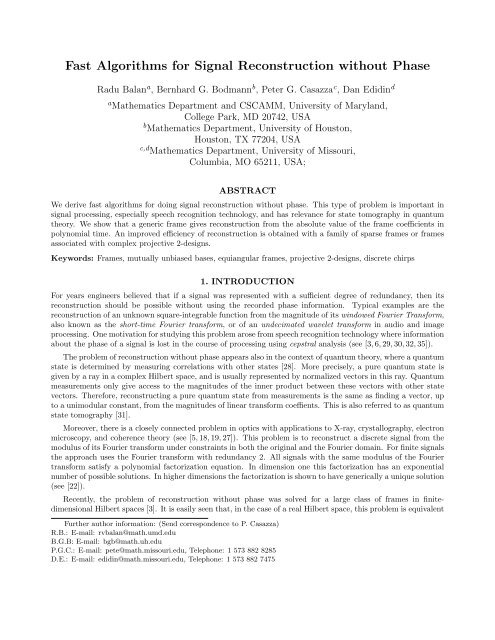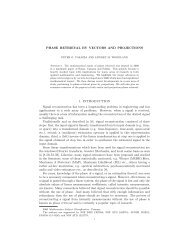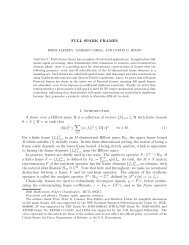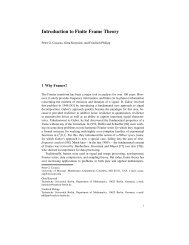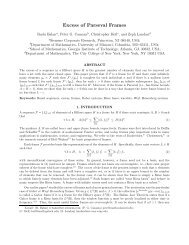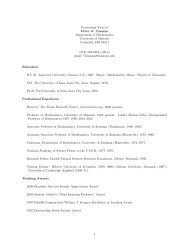Fast Algorithms for Signal Reconstruction without ... - Math Department
Fast Algorithms for Signal Reconstruction without ... - Math Department
Fast Algorithms for Signal Reconstruction without ... - Math Department
You also want an ePaper? Increase the reach of your titles
YUMPU automatically turns print PDFs into web optimized ePapers that Google loves.
<strong>Fast</strong> <strong>Algorithms</strong> <strong>for</strong> <strong>Signal</strong> <strong>Reconstruction</strong> <strong>without</strong> PhaseRadu Balan a , Bernhard G. Bodmann b , Peter G. Casazza c , Dan Edidin da <strong>Math</strong>ematics <strong>Department</strong> and CSCAMM, University of Maryland,College Park, MD 20742, USAb <strong>Math</strong>ematics <strong>Department</strong>, University of Houston,Houston, TX 77204, USAc,d <strong>Math</strong>ematics <strong>Department</strong>, University of Missouri,Columbia, MO 65211, USA;ABSTRACTWe derive fast algorithms <strong>for</strong> doing signal reconstruction <strong>without</strong> phase. This type of problem is important insignal processing, especially speech recognition technology, and has relevance <strong>for</strong> state tomography in quantumtheory. We show that a generic frame gives reconstruction from the absolute value of the frame coefficients inpolynomial time. An improved efficiency of reconstruction is obtained with a family of sparse frames or framesassociated with complex projective 2-designs.Keywords: Frames, mutually unbiased bases, equiangular frames, projective 2-designs, discrete chirps1. INTRODUCTIONFor years engineers believed that if a signal was represented with a sufficient degree of redundancy, then itsreconstruction should be possible <strong>without</strong> using the recorded phase in<strong>for</strong>mation. Typical examples are thereconstruction of an unknown square-integrable function from the magnitude of its windowed Fourier Trans<strong>for</strong>m,also known as the short-time Fourier trans<strong>for</strong>m, or of an undecimated wavelet trans<strong>for</strong>m in audio and imageprocessing. One motivation <strong>for</strong> studying this problem arose from speech recognition technology where in<strong>for</strong>mationabout the phase of a signal is lost in the course of processing using cepstral analysis (see [3, 6, 29, 30, 32, 35]).The problem of reconstruction <strong>without</strong> phase appears also in the context of quantum theory, where a quantumstate is determined by measuring correlations with other states [28]. More precisely, a pure quantum state isgiven by a ray in a complex Hilbert space, and is usually represented by normalized vectors in this ray. Quantummeasurements only give access to the magnitudes of the inner product between these vectors with other statevectors. There<strong>for</strong>e, reconstructing a pure quantum state from measurements is the same as finding a vector, upto a unimodular constant, from the magnitudes of linear trans<strong>for</strong>m coeffients. This is also referred to as quantumstate tomography [31].Moreover, there is a closely connected problem in optics with applications to X-ray, crystallography, electronmicroscopy, and coherence theory (see [5, 18, 19, 27]). This problem is to reconstruct a discrete signal from themodulus of its Fourier trans<strong>for</strong>m under constraints in both the original and the Fourier domain. For finite signalsthe approach uses the Fourier trans<strong>for</strong>m with redundancy 2. All signals with the same modulus of the Fouriertrans<strong>for</strong>m satisfy a polynomial factorization equation. In dimension one this factorization has an exponentialnumber of possible solutions. In higher dimensions the factorization is shown to have generically a unique solution(see [22]).Recently, the problem of reconstruction <strong>without</strong> phase was solved <strong>for</strong> a large class of frames in finitedimensionalHilbert spaces [3]. It is easily seen that, in the case of a real Hilbert space, this problem is equivalentFurther author in<strong>for</strong>mation: (Send correspondence to P. Casazza)R.B.: E-mail: rvbalan@math.umd.eduB.G.B: E-mail: bgb@math.uh.eduP.G.C.: E-mail: pete@math.missouri.edu, Telephone: 1 573 882 8285D.E.: E-mail: edidin@math.missouri.edu, Telephone: 1 573 882 7475
to a combinatorial problem. In [4] it is shown that signal reconstruction from the absolute value of the framecoefficients is equivalent to the solution of a sparse signal optimization problem. In particular, this task can bephrased as minimizing an l p (quasi)norm over a linear constraint.Un<strong>for</strong>tunately, the numerical implementation of such results has been hampered by a lack of good algorithms<strong>for</strong> doing signal reconstruction from the absolute value of the frame coefficients. The purpose of this paper is tointroduce several classes of fast algorithms <strong>for</strong> doing signal reconstruction <strong>without</strong> phase.Our goal is to derive simple algorithms <strong>for</strong> doing signal reconstruction <strong>without</strong> phase. We will use a variety oftools <strong>for</strong> this including generic frames, projective 2-designs, which include equiangular tight frames and mutuallyunbiased bases, in particular discrete chirps. Each of the list of algorithms has its own advantage <strong>for</strong> the problemat hand. In [3] it is shown that a generic frame with 4N −2-elements in an N-dimensional complex Hilbert spacewill yield signal reconstruction from the absolute value of the frame coefficients. In the real case the frames musthave size 2N −1. We will see here that a generic frame will give signal reconstruction <strong>without</strong> phase in polynomialtime. In another paper [2] we construct frames which yield linear reconstruction algorithms. The organization ofthe paper is as follows. In section 2 we introduce the necessary results from frame theory including the classes offrames we will be using. Section 3 gives the results concerning generic frames. Section 4 gives fast algorithms <strong>for</strong>sparse frames. Section 5 contains a review of algorithms from [2] using projective 2-designs. Section 6 containsa review of algorithms from [2] using mutually unbiased bases. Section 7 is a discussion of linear reconstructionalgorithms. Section 8 contains concluding remarks.2. FRAME THEORYWe now introduce the fundamental notions from frame theory used in the paper. The main property of frameswhich makes them so useful in applied problems is their redundancy. That is, each vector in the space hasinfinitely many representations with respect to the frame but it also has one natural representation given by theframe coefficients. The role played by redundancy varies with specific applications. In general, a carefully chosenframe can provide resilience to quantization, resilience to additive noise, numerical stability <strong>for</strong> reconstructionand an ability to capture important signal characteristics. A family of vectors {f i } i∈I is a frame <strong>for</strong> a Hilbertspace H (with lower and upper frame bounds 0 < A ≤ B < ∞ respectively) if <strong>for</strong> all x ∈ H:A‖x‖ 2 ≤ ∑ i∈I|〈x, f i 〉| 2 ≤ B‖x‖ 2 .The numbers {〈x, f i 〉} i∈I are called the frame coefficients. If A = B this is a A-tight frame and if A = B = 1,it is called a Parseval frame. If all the frame elements have the same norm we call this an equal-norm frame.Given a frame {f i } i∈I , the analysis operator is T : H → l 2 (I) given by: T (x) = {〈x, f i 〉} i∈I . The range of T iscalled the range of coefficients. The synthesis operator is the adjoint of T , and satisfiesT ∗ (c) = ∑ i∈Ic i f i .The frame operator is the positive, self-adjoint invertible operator S = T ∗ T : H → H.We refer the reader to [16] <strong>for</strong> an introduction to frame theory.We will need several special classes of frames which we now introduce.Definition 2.1. A family of vectors F = {f j } M j=1 is said to <strong>for</strong>m a 2-uni<strong>for</strong>m A-tight frame if it is equal-normand if there is c > 0 such that <strong>for</strong> all pairs of frame vectors f j and f k , j ≠ k, we have |〈f j , f k 〉| = c.It is well known that there is an upper bound <strong>for</strong> the number of vectors in a tight 2-uni<strong>for</strong>m frame F = {f j } M j=1on an N-dimensional Hilbert space H. In the case of a real H, M ≤ N(N + 1)/2, and in the complex case,M ≤ N 2 . (See [23,2]). The construction of the maximal number of vectors <strong>for</strong> a tight 2-uni<strong>for</strong>m frame is a verydeep and difficult open problem in frame theory.
Definition 2.2. Let H be a real or complex Hilbert space. A family of vectors {e (j)k} in H indexed by k ∈ K ={1, 2, . . . N} and j ∈ J = {1, 2, . . . M} is said to <strong>for</strong>m M mutually unbiased bases if <strong>for</strong> all j, j ′ ∈ J and k, k ′ ∈ Kthe magnitude of the inner product between e (j)kand e (j′ )kis given by′with Kronecker’s symbol δ j,j = 1 and δ j,j ′ = 0 if j ≠ j ′ .|〈e (j)k , e(j′ )k ′ 〉| = δ k,k ′δ j,j ′ + 1 √N(1 − δ j,j ′) ,There are at most M = N + 1 mutually unbiased bases {e j k: 1 ≤ j ≤ M, 1 ≤ k ≤ N} in an N-dimensionalcomplex Hilbert space H [See 17, 2]. The construction of the maximal number of mutually unbiased bases <strong>for</strong>Hilbert spaces of arbitrary dimensions is also a deep and difficult open problem in frame theory. However, it ispossible <strong>for</strong> N a prime power in the complex case and a power of 4 in the real case. (See [9, 10]).Examples of mutually unbiased bases are given by the discrete chirps.Proposition 2.3. Let N be a prime number, ω a primitive N-th root of unity, and denote the canonical basisof C N by {e k } N k=1. Then we identify e(1)k≡ e k and <strong>for</strong> j ∈ {2, 3, . . . N + 1} lete (j)k= 1 √NN ∑l=1ω −(j−1)l2 +kl e l .This defines a family of N + 1 mutually unbiased bases that has been called the discrete chirps [11, 24].3. GENERIC FRAMESIn this section we will show that a generic frame will give signal reconstruction <strong>without</strong> phase and will achievethis in polynomial time. First we will need to define generic.We consider the non-linear mapping taking a vector to the absolute value of its frame coefficients:M : H → l 2 (I) , M(x) = {|〈x, f i 〉|} i∈I (1)If it is necessary to associate this to its frame we will write M F . Let H r = H/ ∼ be the quotient spaceobtained by identifying two vectors if they differ by a constant phase factor. That is, x ∼ y means there is ascalar |c| = 1 so that y = cx. For real Hilbert spaces, c = ±1 while <strong>for</strong> complex Hilbert spaces c = e iθ . Inquantum mechanics, these projective rays define quantum states [33]. The nonlinear mapping M extends to H rasM : H r → l 2 (I) , M(ˆx) = {|〈x, f i 〉|} i∈I , x ∈ ˆx (2)First consider the case H = R N and let l 2 (I) be R M . The set Gr(N, M; R) of N-dimensional linear subspacesof R M has the structure of an N(M − N)-dimensional manifold called the Grassmann manifold [36, p. 129]. Theframe bundle F (N, M; R) is the GL(N, R)-bundle over Gr(N, M) defined as follows: The fiber of F (N, M; R)over a point of GL(N, R) corresponding to an N-dimensional linear subspace W ⊂ R M is the set of all possiblebases <strong>for</strong> W .For a frame F = {f 1 , . . . , f M } of R N the analysis operator T satisfiesT : R N → R M , T (x) =M∑〈x, f k 〉e k , (3)where {e 1 , . . . , e M } is the canonical basis of R M . We let W denote the range of the analysis map T (R N ). It isan N-dimensional linear subspace of R M and thus corresponds to a point of the Grassman manifold Gr(N, M).Two frames {f i } i∈I and {g i } i∈I are equivalent if there is an invertible operator T on H with T (f i ) = g i , <strong>for</strong> alli ∈ I. It is known that two frames are equivalent if and only if their associated analysis operators have the samerange (see [1, 21]). We deduce that M-element frames on R N are parametrized by the fiber bundle F (N, M; R).k=1
y a root of unity in the ground field). Choose i ≤ N such that a i ≠ 0 (such i exists because {f 1 , . . . , f N } spanH) and let b j = a j /a i <strong>for</strong> j = 1, 2, . . . , M. Determining the a j ’s up to to global multiplication by a root of unityis obviously equivalent to computing the b j ’s exactly.Our method is to compute {b 1 , . . . b N } (and thus the other b j ’s) using Guassing elimination. To simplify thenotation we reorder the vectors and assume that b 1 = 1. We now distinguish between the real and complex case.Real Case: For each k ≥ N we know b 2 k . Expanding in terms of the b i’s <strong>for</strong> i ≤ N we obtain the equationN∑b 2 k = ( u k,i b i ) 2=i=1N∑u 2 k,ib 2 i +i=1∑1
These frames have unique reconstruction of vectors (up to multiplication by a root of unity) from the absolutevalues of their frame coefficients with ≤ N calculations.Proof. Let F = {f 1 , . . . , f M } be one of the frames in the statement of the Theorem. Let x ∈ H be a vectorand let a i = 〈x, f i 〉 <strong>for</strong> i = 1, 2, . . . , M be the frame coefficients. Since {e 1 , . . . , e N } span H, a i ≠ 0 <strong>for</strong> someindex 1 ≤ i ≤ N. Let a i be the first non-zero frame coefficient and let b j = a j /a i <strong>for</strong> i = 1, 2, . . . , M (so b i = 1).Given {|a j |} M j=1 we will compute the b k’s <strong>for</strong> i < k ≤ N in N − k steps. From this we can recover x/|a i | and thusthe vector x up to a global multiplication by a root of unity.In the real case we can compute b k from |b k | and |b i + b k | = |1 + b k |. The <strong>for</strong>mula isb k = |1 + b k| 2 − |b k | 2 − 1.2In the complex case we can determine b k from |b k |, |1 + b k | and |1 + √ −1b k |. Here the <strong>for</strong>mula isb k = 1 2(|1 + bk | 2 − √ −1(|1 + √ −1b k | 2 ) + ( √ −1 − 1)(1 + |b k | 2 ) ) .Remark 4.2. If choose an orthonormal basis {e 1 , . . . , e N } <strong>for</strong> H then we can reconstruct the open set ofvectors x with 〈x, e i 〉 ≠ 0 using the algorithm above and the frame {e 1 , . . . , e N } ⋃ {e j + e i } j≠i if H is real or{e 1 , . . . , e N } ⋃ {e j + e i , √ −1e j + e i } j≠i if H is complex.Remark 4.3. One way to decrease the size of our frames is to use early in<strong>for</strong>mation to reduce the numberof frame vectors used. For example, in the real example above, we can reduce the numbers of vectors used to2N-1 and still do reconstruction with N-steps. What we do is compute the absolute value of the inner products{|〈f, e i 〉|} N i=1 . Then go to the first non-zero coefficient, say n. Now we just have to compute the frame coefficientsagainst {e n + e m } N m=n+1 and we will get quick reconstruction as above with just these coefficients.5. ALGORITHMS USING PROJECTIVE 2-DESIGNSNext, we examine frames that are not sparse, but provide us with a simple reconstruction <strong>for</strong>mula using onlythe absolute value of the frame coefficients. This is equivalent to the construction (from the magnitudes of theframe coefficients) of the self-adjoint rank-one operators Q x , x ∈ H given by Q x (y) = 〈y, x〉x, <strong>for</strong> y ∈ H. So inthis section we will work with the projective space of H.Definition 5.1. Let H be a finite-dimensional real or complex Hilbert space and denote by P H the projectivespace of H <strong>for</strong>med by all orthogonal rank-one projections {P : P = P ∗ P } on H. Equivalently, we can identifyeach projection by its range in H and think of this projective space as the set of all one-dimensional subspaces ofH.The projective space P H is naturally embedded in the space X containing all self-adjoint rank-one operators.We define the space of homogeneous k th degree polynomials Hom(k) on P H to consist of functions on Xthat can be expressed in the <strong>for</strong>mh : X ↦→ tr[X ⊗k H] ,with H an operator on H ⊗k .We denote by µ the probability measure on P H which is invariant under the conjugation of the projectionswith orthogonal matrices or unitaries in the real or complex case, respectively.A finite set X in P H is called a projective t-design [25], t ∈ {1, 2, . . . }, if <strong>for</strong> every homogeneous polynomialh ∈ Hom(k) of degree 0 ≤ k ≤ t, we have∫hdµ = 1 ∑h(P ) ,P H |X|P ∈Xwhere |X| denotes the size of the set X.
Two known types of examples <strong>for</strong> projective 2-designs are a maximal equiangular set of lines generated by2-uni<strong>for</strong>m tight frames and the set of lines generated by a maximal set of mutually unbiased bases in H [2].The following theorem from [2] gives a reconstruction <strong>for</strong>mula <strong>for</strong> Q x that only depends on the magnitudesof the frame coefficients when the frame F is associated with a projective 2-design. The proof of this theoremwill appear elsewhere.Theorem 5.2. Let H be a N-dimensional real or complex Hilbert space and F = {f 1 , f 2 , . . . f M } a uni<strong>for</strong>mM/N-tight frame such that the orthogonal projections onto the one-dimensional subspaces containing the framevectors <strong>for</strong>m a projective 2-design in P H. Given a vector x ∈ H with associated self-adjoint rank-one operatorQ x , thenN(N + 1)M∑Q x = |〈x, f j 〉| 2 Q fj − ‖x‖ 2 I .Mj=1Remark 5.3. The above theorem gives an algorithm that allows us to reconstruct x, up to a an overall unimodularconstant, by considering one non-vanishing row of the matrix Q x . Thus, the computation requires onlyO(MN) operations. For our earlier examples of maximal 2-uni<strong>for</strong>m frames and mutually unbiased bases thatyield projective 2-designs, M is of order N 2 . This results in O(N 3 ) operations required <strong>for</strong> reconstruction.6. ALGORITHMS USING MUTUALLY UNBIASED BASESIn this section we will see that <strong>for</strong> a frame which contains a maximal number of mutually unbiased bases, thereconstruction <strong>for</strong>mula <strong>for</strong> signal reconstruction <strong>without</strong> phase is especially simple. The results in this sectioncome from [2] and the proofs will appear elsewhere.Definition 6.1. Let H be a complex Hilbert space of dimension N. Let J = {1, 2, . . . N +1} and K = {1, 2, . . . N}.If the family of vectors {e j k: j ∈ J, k ∈ K} <strong>for</strong>ms N + 1 mutually unbiased bases in H and ω is a primitive N-throot of unity, then we denoteB j k = 1 √NN ∑l=1ω kl P jl ,where <strong>for</strong> each k ∈ K, j ∈ J, P j k is the rank-one orthogonal projection onto the span of ej k .Now we see how to do signal reconstruction using mutually unbiased bases [2].elsewhere.The proof will appearTheorem 6.2. Given a family of vectors {e j k , j ∈ J, k ∈ K} that <strong>for</strong>m N + 1 mutually unbiased bases in CN , aprimitive N-th root of unity ω and the associated operators {B j k }, then <strong>for</strong> all x ∈ CN ,Q x = ‖x‖2N I + √ 1N+1∑Nj=1 k,l=1N∑ω −kl |〈x, e j l 〉|2 B j k .If we use the discrete chirps then the reconstruction <strong>for</strong>mula simplifies to [2].Corollary 6.3. If N is prime and we use the discrete chirps constructed earlier as a maximal set of mutuallyunbiased bases, then the reconstruction <strong>for</strong>mula becomesx n x 1 = 1 N ‖x‖2 δ n,1 + 1 NN+1∑j=1 l=1N∑ω −(j−1)(n2−1)+l(n−1) |〈x, e j l 〉|2 .
7. LINEAR TIME RECONSTRUCTIONAs we saw, the use of 2-designs yields algorithms which do reconstruction <strong>without</strong> phase using O(N 3 ) operations<strong>for</strong> an N-dimensional Hilbert space. Using the <strong>Fast</strong> Fourier Trans<strong>for</strong>m gives some improvement <strong>for</strong> the specialcase of chirps. In [2] there also appear much faster algorithms requiring on the order of N operations. Theconstruction of these frames involves combining the earlier constructions with the notion of fusion frames [12–14](see also [7]). The algorithm at first looks like it also needs a number of operations which is quadratic in N. Butit is then modified so that only a portion of the coefficients are actually used in reconstruction reducing overallthe number of calculations to linear in N.8. CONCLUSIONWe have seen that a generic frame of sufficient size will give signal reconstruction <strong>without</strong> phase in a polynomialnumber of steps. We have also seen that <strong>for</strong> certain tight frames, there are remarkably simple reconstructionalgorithms that only use the magnitudes of the frame coefficients. One reason <strong>for</strong> obtaining a simple expressionis the use of projective 2-designs. Since examples <strong>for</strong> such designs have a small set of possible magnitudes <strong>for</strong>inner products between frame vectors, the general reconstruction <strong>for</strong>mula can be simplified even further.Furthermore, we have demonstrated that there are frames <strong>for</strong> which the number of operations required <strong>for</strong>reconstruction only grows linearly with the dimension of the Hilbert space.<strong>Reconstruction</strong> <strong>without</strong> phase is also of interest when coefficients are lost, e.g. in the course of a datatransmission [8, 15, 20, 26]. Since 2-uni<strong>for</strong>m tight frames are in certain situations optimal <strong>for</strong> a small numberof lost coefficients, [8], it may be worthwhile pursuing how well reconstruction <strong>without</strong> phase per<strong>for</strong>ms in thepresence of lost coefficients. This topic will be pursued in another work.ACKNOWLEDGMENTSB.G.B. has been partially supported by the Natural Sciences and Research Engineering Council of Canada.P.G.C. acknowledges support from NSF DMS 0704216, D.E. acknowledges support from the University of MissouriResearch Board.REFERENCES1. R. Balan. Equivalence relations and distances between Hilbert frames. Proc. Amer. <strong>Math</strong>. Soc., 127(8):2353–2366, 1999.2. R. Balan, B. G. Bodman, P. G. Casazza and D. Edidin, Painless reconstruction from magnitudes of framecoefficients, preprint.3. R. Balan, P. Casazza, D. Edidin, On signal reconstruction <strong>without</strong> phase, Appl.Comput.Harmon.Anal. 20(2006), 345–356.4. R. Balan, P. Casazza, D. Edidin, Equivalence of <strong>Reconstruction</strong> from the Absolute Value of the Frame Coefficientsto a Sparse Representation Problem, to appear in IEEE <strong>Signal</strong> Proc. Letters (2007).5. R. H. Bates and D. Mnyama. The status of practical Fourier phase retrieval, in W. H. Hawkes, ed., Advancesin Electronics and Electron Physics, 67:1–64, 1986.6. C. Becchetti and L. P. Ricotti. Speech recognition theory and C++ implementation. Wiley (1999).7. B. G. Bodmann, Optimal linear transmission by loss-insensitive packet encoding, Appl. Comput. Harmon.Anal. 22 (2007), 274–285.8. B. G. Bodmann and V. I. Paulsen, Frames, graphs and erasures, Linear Algebra Appl. 404 (2005), 118–146.9. A. R. Calderbank, P. J. Cameron, W. M. Kantor, and J. J. Seidel, Z 4 -Kerdock codes, orthogonal spreads,and extremal Euclidean line-sets, Proc. London <strong>Math</strong>. Soc. (3) 75 (1997), no. 2, 436–480.10. P. J. Cameron and J. J. Seidel, Quadratic <strong>for</strong>ms over GF (2), Indag. <strong>Math</strong>. 35 (1973), 1–8.11. P. G. Casazza and M. Fickus, Fourier trans<strong>for</strong>ms of finite chirps, EURASIP J. Appl. <strong>Signal</strong> Process. (2006),Frames and overcomplete representations in signal processing, communications, and in<strong>for</strong>mation theory, Art.ID 70204, 1-7.
12. P. G. Casazza and G. Kutyniok, Frames of subspaces, Wavelets, frames and operator theory, Contemp.<strong>Math</strong>., vol. 345, Amer. <strong>Math</strong>. Soc., Providence, RI, 2004, pp. 87–113.13. P. G. Casazza and G. Kutyniok, Robustness of fusion frames under erasures of subspaces and of local framevectors, Contemporary <strong>Math</strong> (to appear).14. P. G. Casazza, G. Kutyniok and S. Li, Fusion frames and distributed processing, preprint.15. P. Casazza and J. Kovačević, Equal-norm tight frames with erasures, Adv. Comp. <strong>Math</strong>. 18 (2003), 387–430.16. O. Christensen, An Introduction to Frames and Riesz Bases, Birkhäuser, Boston, 2003.17. P. Delsarte, J. M. Goethals, and J. J. Seidel, Spherical codes and designs, Geometriae Dedicata 6 (1977),no. 3, 363–388.18. J. R. Fienup. <strong>Reconstruction</strong> of an object from the modulus of its fourier trans<strong>for</strong>m, Optics Letters, 3 (1978),27–29.19. J. R. Fienup. Phase retrieval algorithms: A comparison, Applied Optics, 21 (15) (1982), 2758–2768.20. V. K. Goyal, J. Kovačević, and J. A. Kelner, Quantized frame expansions with erasures, Appl. Comp. Harm.Anal. 10 (2001), 203–233.21. D. Han and D. Larson. Frames, bases and group representations, Memoirs American <strong>Math</strong>. Soc. 147 (2000),no. 697.22. M. H. Hayes. The reconstruction of a multidimensional sequence from the phase or magnitude of its fouriertrans<strong>for</strong>m. IEEE Trans. ASSP, 30 (2) (1982), 140–154.23. R. Holmes and V. I. Paulsen, Optimal frames <strong>for</strong> erasures, Lin. Alg. Appl. 377 (2004), 31–51.24. S. D. Howard, A. R. Calderbank, and W. Moran, The finite Heisenberg-Weyl groups in radar and communications,EURASIP J. Appl. <strong>Signal</strong> Process. (2006), no. Frames and overcomplete representations in signalprocessing, communications, and in<strong>for</strong>mation theory, Art. ID 85685, 1-12.25. A. Klappenecker and M. Rötteler, Mutually unbiased bases are complex projective 2-designs, Proc. Int. Symp.on Inf. Theory, IEEE, 2005, pp. 1740–1744.26. J. Kovačević, P. L. Dragotti, and V. K. Goyal, Filter bank frame expansions with erasures, IEEE Trans.In<strong>for</strong>m. Theory 48 (2002), 1439–1450.27. G. Liu. Fourier phase retrieval algorithm with noise constraints, <strong>Signal</strong> Processing, 21(4):339–347, 1990.28. A. Peres, Quantum Theory: Concepts and Methods, Kluwer, Dordrecht, 1993.29. J.G. Proakis. <strong>Algorithms</strong> <strong>for</strong> statistical signal processing. Prentice Hall (2002).30. J. G. Proakis, J. R. Deller and J. H. L. Hansen. Discrete-Time processing of speech signals. IEEE Press(2000).31. J. M. Renes, R. Blume-Kohout, A. J. Scott, and C. M. Caves, Symmetric In<strong>for</strong>mationally Complete QuantumMeasurements, J. <strong>Math</strong>. Phys., vol. 45, pp. 2171–2180, 2004.32. L. Rabiner and B. H. Juang. Fundamentals of speech recognition. Prentice Hall <strong>Signal</strong> Processing Series(1993).33. R. F. Streater and A. S. Wightman. PCT, Spin and Statistics and All That. Princeton University Press,Landmarks in <strong>Math</strong>ematics and Physics, 2000.34. M. Strauss, Private communication.35. S. V. Vaseghi. Advanced digital signal processing and noise reduction. Wiley (2002).36. F. W. Warner. Foundations of differential manifolds and Lie groups Graduate Texts in <strong>Math</strong>ematics 94.Springer-Verlag 1983.


